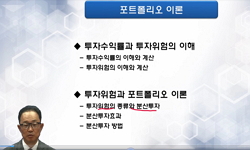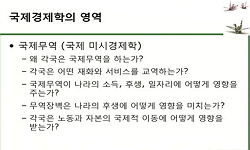Many studies including DeBondt and Thaler (1985), Jegadeesh (1990) report that contrarian investment strategy buying loser stocks and selling winner stocks produce long-horizon returns that exceed market average returns. In the literature, the profita...
http://chineseinput.net/에서 pinyin(병음)방식으로 중국어를 변환할 수 있습니다.
변환된 중국어를 복사하여 사용하시면 됩니다.
- 中文 을 입력하시려면 zhongwen을 입력하시고 space를누르시면됩니다.
- 北京 을 입력하시려면 beijing을 입력하시고 space를 누르시면 됩니다.

과거 거래량과 수익률에 기초한 포트폴리오 투자성과 분석 = The Profitability of Potfolio Investment Based on the Past Trading Volume and Returns
한글로보기https://www.riss.kr/link?id=A103799091
- 저자
- 발행기관
- 학술지명
- 권호사항
-
발행연도
2012
-
작성언어
Korean
-
주제어
Trading Volume ; Stock Return ; Portfolio ; Contrarian Investment Strategy ; Time-Varying Risk. ; 거래량 ; 수익률 ; 포트폴리오 ; 역행투자전략 ; 시간가변 위험
-
등재정보
KCI등재
-
자료형태
학술저널
- 발행기관 URL
-
수록면
243-259(17쪽)
-
KCI 피인용횟수
12
- 제공처
-
0
상세조회 -
0
다운로드
부가정보
다국어 초록 (Multilingual Abstract)
There is the long-running debate that centers on whether the contrarian profitability is related to astute investors or compensation for great risk inherent in contrarian the investment strategy. We study the long-term overreaction phenomenon with trading volume as the key analytical variable. We examine the difference in time-varying risk-return characteristics of the profitability of winner, loser, and contrarian protfolio among stocks with different levels of trading volume. Portfolios are formed annually based on the three-year trading volume and returns under overlapping six-year study method. And we estimate average excess return and cumulative excess return for winner and loser portfolio, and contrarian investment strategy. We also evaluate time-varying risk and return relation found in the portfolios against the market. The data for this empirical analysis are obtained form KIS-value and FnGuide database.
We show that (i) high-trading volume contrarian investment strategy earns a much higher cumulative excess returns than low-trading volume contrarian investment strategy, (ii) high-trading volume contrarian investment strategy earns a much higher market-adjusted excess return than the low-trading volume contrarian investment strategy, (iii) excess returns from high-volume contrarian investment strategy are significant and can not explained by the time-varying risk and return framework.
Many studies including DeBondt and Thaler (1985), Jegadeesh (1990) report that contrarian investment strategy buying loser stocks and selling winner stocks produce long-horizon returns that exceed market average returns. In the literature, the profitability of such contrarian investment strategy is often linked to well-documented phenomenon of asymmetric time-varying risk in stock market returns.
There is the long-running debate that centers on whether the contrarian profitability is related to astute investors or compensation for great risk inherent in contrarian the investment strategy. We study the long-term overreaction phenomenon with trading volume as the key analytical variable. We examine the difference in time-varying risk-return characteristics of the profitability of winner, loser, and contrarian protfolio among stocks with different levels of trading volume. Portfolios are formed annually based on the three-year trading volume and returns under overlapping six-year study method. And we estimate average excess return and cumulative excess return for winner and loser portfolio, and contrarian investment strategy. We also evaluate time-varying risk and return relation found in the portfolios against the market. The data for this empirical analysis are obtained form KIS-value and FnGuide database.
We show that (i) high-trading volume contrarian investment strategy earns a much higher cumulative excess returns than low-trading volume contrarian investment strategy, (ii) high-trading volume contrarian investment strategy earns a much higher market-adjusted excess return than the low-trading volume contrarian investment strategy, (iii) excess returns from high-volume contrarian investment strategy are significant and can not explained by the time-varying risk and return framework.
국문 초록 (Abstract)
둘째, 거래량이 많은 역행투자전략의 성과는 거래량이 적은 역행투자전략에 비해 높게 나타났다. 특히, 거래량이 많은 역행투자전략의 성과는 패자포트폴리오에서 발견된 수익률 반전현상에 기인한 것으로 평가되었다. 셋째, 시간가변 위험-수익률 모형에 의한 투자성과의 분석결과, 승자와 패자 그리고 거래량이 많은 역행투자전략에서 모두 유의한 양(+)의 비정상수익률이 발견되었다. 이는 과거 거래량과 수익률에 기초한 포트폴리오 및 투자전략의 성과가 시간가변 위험을 고려한 체계적 위험에 의하여 충분히 설명될 수 없음을 보여주는 증거가 된다.
본 연구는 거래량이 포트폴리오 및 역행투자전략의 성과를 예측하는 데 추가적인 정보를 제공할 수 있다는 측면에서 시사점을 제공한다
본 연구는 한국주식시장을 대상으로 과거 거래량과 수익률 정보를 이용한 포트폴리오 및 투자전략의 성과를 분석하고, 이러한 성과가 시간가변 위험(time-varying risk)에 근거한 것인지를 살펴...
본 연구는 한국주식시장을 대상으로 과거 거래량과 수익률 정보를 이용한 포트폴리오 및 투자전략의 성과를 분석하고, 이러한 성과가 시간가변 위험(time-varying risk)에 근거한 것인지를 살펴보았다. 연구기간은 1993년부터 2011년 10월까지로 약 19년간이며, 분석의 목적상 중복기간(overlapping period) 산정방식에 따라 전체 연구기간을 매 6년씩 나누어 총 14개의 하위 연구기간을 설정하였다. 각 하위 연구기간에서 과거 3년간의 거래량과 수익률에 기초하여 포트폴리오를 구성한 뒤, 구성시점 이후 3년간을 투자성과 측정을 위한 보유기간(holding period)으로 삼았다. 포트폴리오 및 투자전략의 성과는 누적초과수익률(cumulative excess return)과 월평균초과수익률(average excess return)을 이용하여 측정하였다. 그리고 시간가변 위험-수익률 모형을 이용하여 투자성과가 체계적 위험으로 설명될 수 있는지 살펴보았다. 본 연구에서의 주요 결과는 다음과 같다. 첫째, 거래량이 많은 패자포트폴리오와 승자포트폴리오는 보유기간에 걸쳐 양(+)의 누적초과수익률을 보였고, 수익률의 추세는 지속적으로 상승하는 형태로 나타났다. 반면, 거래량이 적은 패자포트폴리오와 승자포트폴리오는 보유기간 동안 모두 음(-)의 누적초과수익률을 기록하였다.
둘째, 거래량이 많은 역행투자전략의 성과는 거래량이 적은 역행투자전략에 비해 높게 나타났다. 특히, 거래량이 많은 역행투자전략의 성과는 패자포트폴리오에서 발견된 수익률 반전현상에 기인한 것으로 평가되었다. 셋째, 시간가변 위험-수익률 모형에 의한 투자성과의 분석결과, 승자와 패자 그리고 거래량이 많은 역행투자전략에서 모두 유의한 양(+)의 비정상수익률이 발견되었다. 이는 과거 거래량과 수익률에 기초한 포트폴리오 및 투자전략의 성과가 시간가변 위험을 고려한 체계적 위험에 의하여 충분히 설명될 수 없음을 보여주는 증거가 된다.
본 연구는 거래량이 포트폴리오 및 역행투자전략의 성과를 예측하는 데 추가적인 정보를 제공할 수 있다는 측면에서 시사점을 제공한다
참고문헌 (Reference)
1 김태혁, "한국주식시장에 있어서 반전거래전략과 계속거래전략의 경제적 유용성에 관한 비교연구" 한국재무관리학회 14 : 73-111, 1997
2 김창수, "코스닥시장의 효율성에 관한 연구" 한국증권학회 27 : 331-361, 2000
3 안영규, "주식수익률과 거래량을 이용한 투자전략의 성과분석" 한국증권학회 33 (33): 105-137, 2004
4 고봉찬, "위험프레미엄과 상대적세력 투자전략의 수익성" 한국재무관리학회 14 : 1-21, 1997
5 감형규, "모멘텀 효과를 이용한 투자전략의 성과에 관한 연구" 한국기업경영학회 18 (18): 265-278, 2011
6 이한재, "거래량을 이용한 계속투자전략과 반전효과" 한국산업경제학회 17 (17): 909-929, 2004
7 Conrad, J, "Volume and Autocovariances in Short-Horizon Individual Security Returns" 49 : 1305-1329, 1994
8 Scowcroft, A, "Understanding momentum" 61 : 64-82, 2005
9 Campbell, J, "Trading Volume and Serial Correlationin Stock Returns" 107 : 905-939, 1993
10 Lewellen, J, "The Time-series Relations among Expected Return, Risk, and Bookto- market" 54 : 5-43, 1999
1 김태혁, "한국주식시장에 있어서 반전거래전략과 계속거래전략의 경제적 유용성에 관한 비교연구" 한국재무관리학회 14 : 73-111, 1997
2 김창수, "코스닥시장의 효율성에 관한 연구" 한국증권학회 27 : 331-361, 2000
3 안영규, "주식수익률과 거래량을 이용한 투자전략의 성과분석" 한국증권학회 33 (33): 105-137, 2004
4 고봉찬, "위험프레미엄과 상대적세력 투자전략의 수익성" 한국재무관리학회 14 : 1-21, 1997
5 감형규, "모멘텀 효과를 이용한 투자전략의 성과에 관한 연구" 한국기업경영학회 18 (18): 265-278, 2011
6 이한재, "거래량을 이용한 계속투자전략과 반전효과" 한국산업경제학회 17 (17): 909-929, 2004
7 Conrad, J, "Volume and Autocovariances in Short-Horizon Individual Security Returns" 49 : 1305-1329, 1994
8 Scowcroft, A, "Understanding momentum" 61 : 64-82, 2005
9 Campbell, J, "Trading Volume and Serial Correlationin Stock Returns" 107 : 905-939, 1993
10 Lewellen, J, "The Time-series Relations among Expected Return, Risk, and Bookto- market" 54 : 5-43, 1999
11 Liu, W, "The Profitability of Momentum Investing" 9 : 1043-1091, 1999
12 Mun, J. C, "Test of Contrarian Investment StrategyEvidence from the French and German StockMarkets" 8 : 215-234, 1999
13 Antoniou, A, "Short-term Contrarion Strategiesin London Stock Exchange : Are They Profitable?Which Factors Affect Them?" 33 : 839-867, 2006
14 Bowman, R, "Short-run Overreaction in the New Zealand Stock Market" 6 : 475-491, 1998
15 Wongchoti, U., "Risk-adjusted Long-Term Contarian Profits : Evidence from Non-S&P 500 High-Volume Stocks" 40 : 335-359, 2005
16 Jegadeesh, N, "Returns to Buying Winners and Selling Losers : Implications for Stock Market Efficiency" 48 : 65-91, 1993
17 Jegadeesh, N, "Profitability of Momentum Strategies : An Evaluation of Alternative Explanations" 56 : 699-720, 2001
18 Lee, C., "Price Momentum and Trading Volume" 55 : 2017-2069, 2000
19 Da Costa Jr, N. C. A, "Overreaction in the Brazilian Stock Market" 18 : 633-642, 1994
20 Chan, K. C, "On the Contrarian Investment Strategy" 61 : 147-163, 1988
21 Dissanaike, G, "On the Computation of Returns in Test of the Stock Market Overreaction Hypothesis" 18 : 1083-1094, 1994
22 Fama, E. F, "Multifactor Explanations of Asset Pricing Anomalies" 51 : 55-84, 1996
23 Blume, L, "Market Statistics and Technical Analysis : The Role of Volume" 49 : 153-181, 1994
24 Datar, V., "Liquidity and Asset Returns : An Alternative Test" 1 : 203-220, 1998
25 Rouwenhorst, K. G, "International Momentum Strategies" 53 : 267-284, 1998
26 Griffin, J. M, "Global Momentum Strategies : A PortfolioPerspective" 4 : 23-29, 2005
27 DeBondt, W, "Further Evidence on Investor Overreaction and Stock Market Seasonality" 42 : 557-581, 1988
28 Jegadeesh, N, "Evidence of Predictable Behavior of Security Returns" 45 : 881-898, 1990
29 DeBondt, W, "Does the Stock Market Overreact?" 40 : 793-808, 1985
30 Schiererck, D, "Contrarian and Momentum Strategies inGermany" 55 : 104-116, 1999
31 Kang, J, "Contrarian and Momentum Strategies in the China Stock Market : 1993~2000" 10 : 243-265, 2002
32 Fama, E. F, "Common Risk Factors in the Returns on Stocks and Bonds" 33 : 3-56, 1993
33 Sharpe, W. F, "Capital Asset Prices: A Theory of Market Equilibrium under Conditions of Risk" 19 : 425-442, 1964
34 Jones, L. S, "Another Look at Time-Varying Risk and Return in a Long-Horizon Contrarian Strategy" 33 : 119-144, 1993
35 Conrad, J., "An Anatomy of Trading Strategies" 11 : 489-519, 1998
동일학술지(권/호) 다른 논문
-
비상장 중소기업의 기업인수성과 -정책자금 지원기업을 대상으로-
- 한국기업경영학회
- 송치승
- 2012
- KCI등재
-
은행서비스에서의 서비스품질, 고객만족도 및 교차구매의도 간의 관계연구: 한․중 은행 간 비교
- 한국기업경영학회
- 이상석
- 2012
- KCI등재
-
기호학적 분석을 통한 인터넷쇼핑몰의 특성 연구 -인터넷 서점의 마케팅특성을 중심으로-
- 한국기업경영학회
- 허남일
- 2012
- KCI등재
-
- 한국기업경영학회
- 송준호
- 2012
- KCI등재
분석정보
인용정보 인용지수 설명보기
학술지 이력
| 연월일 | 이력구분 | 이력상세 | 등재구분 |
|---|---|---|---|
| 2026 | 평가예정 | 재인증평가 신청대상 (재인증) | |
| 2020-01-01 | 평가 | 등재학술지 유지 (재인증) |  |
| 2017-01-01 | 평가 | 등재학술지 유지 (계속평가) |  |
| 2013-01-01 | 평가 | 등재학술지 유지 (등재유지) |  |
| 2010-01-01 | 평가 | 등재학술지 선정 (등재후보2차) |  |
| 2009-03-13 | 학회명변경 | 영문명 : 미등록 -> Korean Corporation Management Association |  |
| 2009-01-01 | 평가 | 등재후보 1차 PASS (등재후보1차) |  |
| 2007-01-01 | 평가 | 등재후보학술지 선정 (신규평가) |  |
학술지 인용정보
| 기준연도 | WOS-KCI 통합IF(2년) | KCIF(2년) | KCIF(3년) |
|---|---|---|---|
| 2016 | 1.56 | 1.56 | 1.63 |
| KCIF(4년) | KCIF(5년) | 중심성지수(3년) | 즉시성지수 |
| 1.75 | 1.7 | 2.494 | 0.42 |





 KCI
KCI eArticle
eArticle






